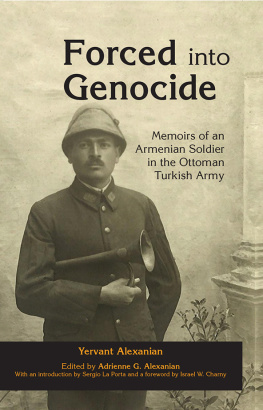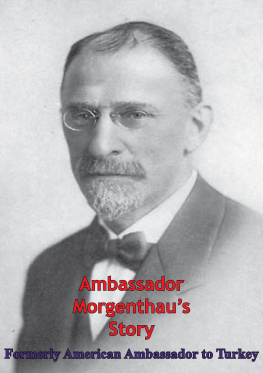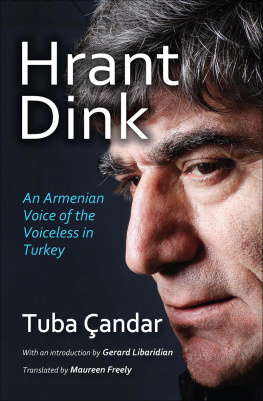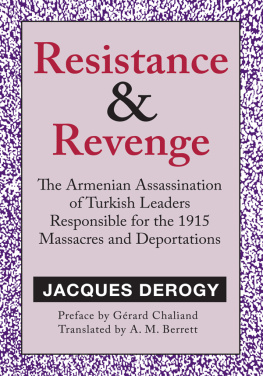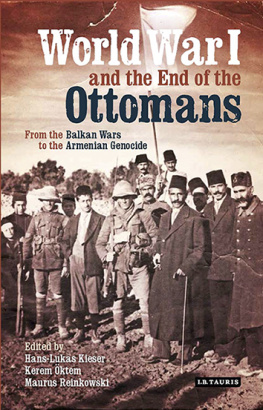Forced into Genocide
Armenian Studies Series
Gerard J. Libaridian, editor
The Armenian Studies series promotes the study of early modern and contemporary Armenian society. The series pays special attention to developments within Armenian society, the societys interactions with external forces, and the effects of modernization on the Armenian people.
Titles in this series include:
Out of My Great Sorrows
Hrant Dink
Sacred Justice
The Grandchildren
The Armenians in the Medieval Islamic World (Volume 1)
The Armenians in the Medieval Islamic World (Volume 2)
The Armenians in the Medieval Islamic World (Volume 3)
Crime of Numbers
A Perfect Injustice
Armenian Organization and Ideology under Ottoman Rule
Cultivating Nationhood in Imperial Russia
The Armenian Genocide
The Pain of Knowledge
Looking Backward, Moving Forward
Taking Lives
Armenian Americans
Resistance and Revenge
First published 2017 by Transaction
Publishers Published 2017 by Routledge
2 Park Square, Milton Park, Abingdon, Oxon OX14 4RN
711 Third Avenue, New York, NY 10017, USA
Routledge is an imprint of the Taylor & Francis Group, an informa business
Copyright 2017 by Adrienne G. Alexanian.
All rights reserved. No part of this book may be reprinted or reproduced or utilised in any form or by any electronic, mechanical, or other means, now known or hereafter invented, including photocopying and recording, or in any information storage or retrieval system, without permission in writing from the publishers.
Notice:
Product or corporate names may be trademarks or registered trademarks, and are used only for identification and explanation without intent to infringe.
ISBN: 978-1-4128-6552-4 (hbk)
Library of Congress Control Number: 2016055997
Praise for Forced into Genocide
One of the biggest hurdles to being able to truly understand history to create simple contrasts and simplify things that render everything in black and white. All of the living that occurs in the gray area gets lost. The life story you have before you of Yervant (Edward) Alexanian belongs to that gray area that cannot be visible within this simplification but should not be neglected at all if you want to grasp the enormity of human catastrophe. It is usually stated that the Armenians who were conscripted into military service were exterminated first but this causes us to forget the story of the hundreds of Armenians, like Yervant (Edward) Alexanian, who served in the Ottoman army battling through to the end of the war. Hundreds of other Armenians, like Yervant, served in the Ottoman army and fought until the end, even bestowed medals for their bravery during a period when their close friends, relatives, and family members were exterminated. Reading about Yervants story is an inescapable part of understanding another kind of suffering; the suffering of survivors.
Dr. Taner Akcam, Clark University, author of
A Shameful Act: The Armenian Genocide and the Question of Turkish Responsibility
Many accounts have been written about the Armenian Genocide, which marked its centennial last year and constitutes the darkest period in the history of the Armenian people. The story of Yervant Alexanian, originally of the city of Sivas, tells the unique and compelling tale of a boy whose conscription into the Ottoman Army ultimately saved him from the fate of fifty-one of his relatives, all of whom perished in the Genocide. Forced into Genocide lovingly memorializes the fate of a family and a community and adds yet another incredible chapter to the history of the Genocide. This book is moving, uplifting, and richly detailed and is a gift to the Armenian community and, indeed, humanity.
Dr. Vartan Gregorian, president, The Carnegie Corporation
Yervant Alexanians story of survival offers a unique glimpse into the oft-forgotten lives and experiences of Armenians who were torn from their families and conscripted into the Ottoman Turkish Army during the Armenian Genocide. Alexanians first-person account sheds light on this tragic moment in historythe first genocide of the twentieth century. This memoir serves as an important contribution to the body of historical accounts of the Armenian Genocide.
The Honorable Frank Pallone, Jr.
The story of Yervant Alexanian provides significant insight into not only the tragedy of the Armenians who lost their lives during the Genocide but also, very importantly, it tells us the forgotten stories of Armenians who served in the World War I Ottoman Army. As disturbing as Alexanians story is, it gives us a rare glimpse of another facet of the Genocide.
Eric Bogosian, author of Operation Nemesis
Yervant Alexanian has left us a much-needed inside account of the Genocide period. As such a witness, he painstakingly works to debunk the alibis, myths, and outright falsehoods long promoted by Turkey to deny the facts of the Armenian Genocide. Unforgettable is the way Alexanian provides humanizing portraitsnot only of the Armenian victims but also those in Ottoman Empire who played roles as agents of mercy or death. His story is long overdue.
Andrew Goldberg, executive producer, The Armenian Genocide
Translations from Armenian: Simon Beugekian (in collaboration with Adrienne G. Alexanian)
Editor: Adrienne G. Alexanian
Translations from Ottoman Turkish: Garabet Moumdjian
Coordinator: Christopher Zakian
Consultant: Gerard Libaridian
Every memoir of an eyewitness and survivor of a genocide touches ones heart deeply, and Yervant (Edward) Alexanians memoir is certainly one of these. At the same time, it is an unusual accountthe first I have ever seenof an Armenian who survives the terrible killing of his people while continuing to serve in the Turkish Army! (I have seen a few reports of Jews who remained alive in the German Army during the Holocaust), and we learn there were others like him.
See also the translators thoughtful preface asking how these survivors could do so. This memoir is also unusually rich in the generous collection of photographs of the time which are not only interesting but also in themselves powerful reminders of the everyday people, like all of us, who perished in the Armenian Genocide. It also presents a rich array of actual documents that make one feel closer to the actual times of the events and the realness of the people.
Thank you, daughter of the deceased survivor, for publishing this special memoir.
Israel W. Charny
Mr. Yervant Alexanians memoir provides a rare glimpse into the life of a survivor of the Armenian Genocide. He did not march through the desert and survive the concentration camps; rather, his memoir tells the story of a young man who survived through serving in the Ottoman Army. Alexanians life (1895-1983) spanned one of the most trying times for Armenians. As he himself notes, he was born in the course of the Hamidian Massacres of 1894-1896 in the city of Sebastia (Sepastia), modern-day Sivas in the Republic of Turkey. Those massacres claimed the lives of approximately 200,000 people. According to Alexanian, the trauma of those massacres also claimed the life of his father who died in 1896 at the age of 42. His mother, Hunazant, was widowed and left with the task of raising eight children, the youngest of whom was Yervant. As Alexanian grew up, most of his immediate family dispersed and headed to the United States, while he was eventually drafted into the Ottoman Army. An indispensable member of his company due to an ability to play the bugle, Alexanian miraculously survived the atrocities that claimed fifty-one members of his family, including his mother and one of his brothers. Alexanians life need not be summarized here, but I will seek to briefly put the events that Alexanian witnessed and experienced within an historical context for those who may be unfamiliar with the history of the Armenian Genocide as well as address the difficult question of the value of a memoir as a source for historical research.

